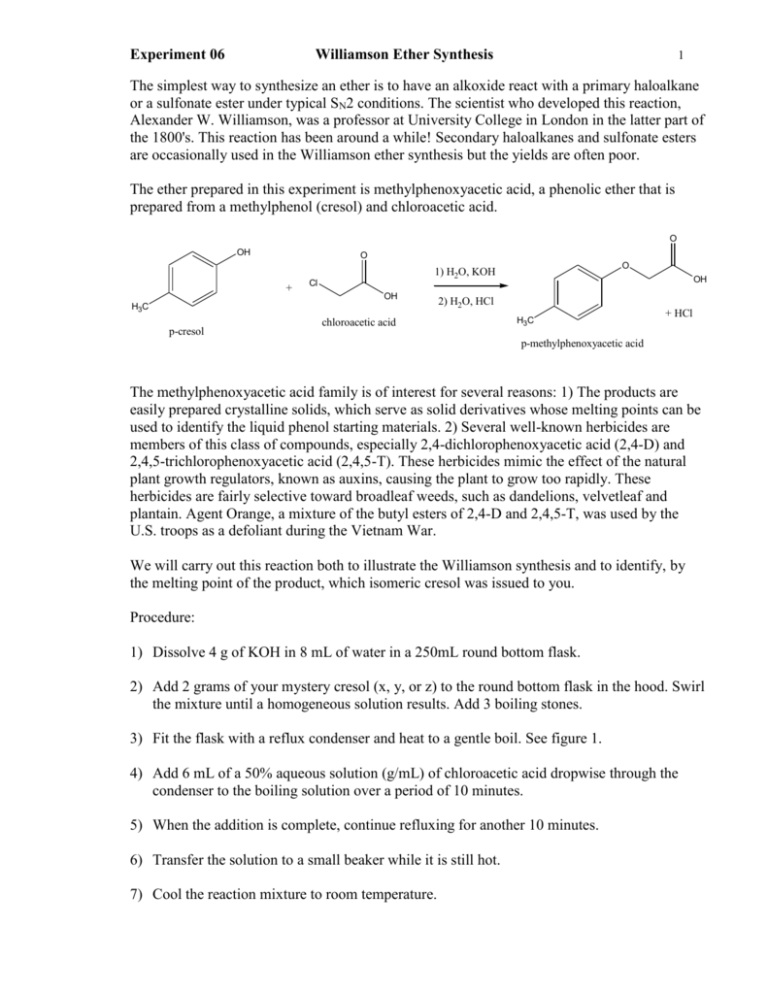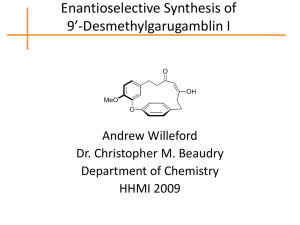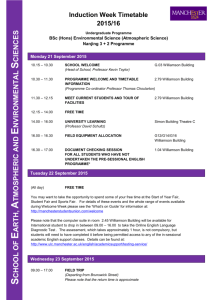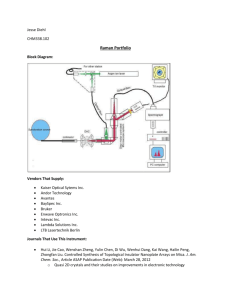Williamson Ether Synthesis – Procedure
advertisement

Experiment 06 Williamson Ether Synthesis 1 The simplest way to synthesize an ether is to have an alkoxide react with a primary haloalkane or a sulfonate ester under typical SN2 conditions. The scientist who developed this reaction, Alexander W. Williamson, was a professor at University College in London in the latter part of the 1800's. This reaction has been around a while! Secondary haloalkanes and sulfonate esters are occasionally used in the Williamson ether synthesis but the yields are often poor. The ether prepared in this experiment is methylphenoxyacetic acid, a phenolic ether that is prepared from a methylphenol (cresol) and chloroacetic acid. O OH O + Cl OH H3C p-cresol O 1) H2O, KOH OH 2) H2O, HCl chloroacetic acid H3C + HCl p-methylphenoxyacetic acid The methylphenoxyacetic acid family is of interest for several reasons: 1) The products are easily prepared crystalline solids, which serve as solid derivatives whose melting points can be used to identify the liquid phenol starting materials. 2) Several well-known herbicides are members of this class of compounds, especially 2,4-dichlorophenoxyacetic acid (2,4-D) and 2,4,5-trichlorophenoxyacetic acid (2,4,5-T). These herbicides mimic the effect of the natural plant growth regulators, known as auxins, causing the plant to grow too rapidly. These herbicides are fairly selective toward broadleaf weeds, such as dandelions, velvetleaf and plantain. Agent Orange, a mixture of the butyl esters of 2,4-D and 2,4,5-T, was used by the U.S. troops as a defoliant during the Vietnam War. We will carry out this reaction both to illustrate the Williamson synthesis and to identify, by the melting point of the product, which isomeric cresol was issued to you. Procedure: 1) Dissolve 4 g of KOH in 8 mL of water in a 250mL round bottom flask. 2) Add 2 grams of your mystery cresol (x, y, or z) to the round bottom flask in the hood. Swirl the mixture until a homogeneous solution results. Add 3 boiling stones. 3) Fit the flask with a reflux condenser and heat to a gentle boil. See figure 1. 4) Add 6 mL of a 50% aqueous solution (g/mL) of chloroacetic acid dropwise through the condenser to the boiling solution over a period of 10 minutes. 5) When the addition is complete, continue refluxing for another 10 minutes. 6) Transfer the solution to a small beaker while it is still hot. 7) Cool the reaction mixture to room temperature. Experiment 06 Williamson Ether Synthesis 2 8) Acidify the solution with dropwise addition of concentrated HCl. Monitor the pH with pH paper. 9) Cool the mixture in an ice bath. Be sure the precipitate has solidified before filtering it. 10) Filter the precipitate by vacuum filtration. 11) Recrystallize the crude solid from boiling water. Do not use more than 50 mL of water. 12) Filter the precipitate by vacuum filtration. 13) Allow the solid to air dry in your laboratory drawer. 14) Weigh the solid and obtain the melting point during the next week’s laboratory period. 15) Hand in a properly labeled sample of your product. Include your name, melting point of product, name of product. Disposal: Liquids in liquid disposal. Solids in solid disposal. Experiment 06 Williamson Ether Synthesis Prelab: Checklist for completing the "Prelab" section: (refer to Laboratory Syllabus for complete directions) ____ Title. ____ Purpose. Physical constants. Create a table of physical constants and safety data for: o-cresol m-cresol p-cresol chloroacetic acid solid potassium hydroxide concentrated aqueous hydrochloric acid o-methylphenoxyacetic acid m-methylphenoxyacetic acid p-methylphenoxyacetic acid _____References 3 Experiment 06 Williamson Ether Synthesis 4 Structures and equations. 1) This synthesis is a "one-pot" four-step reaction. a) Write the equation for the first step (step 2) of the procedure using the complete structures. O H +K K OH + H3C b) Write the equation for the second step (step 4) of the procedure using the complete structures. O Cl C C H2 O H +K OH K + c) Write the equation for the third step (SN2 reaction) of the procedure using the complete structures. d) Write the equation for the fourth step (step 8) of the procedure using the complete structures. ___ Flowchart. Refer to "Procedure" Calculations. 1) Calculate the number of moles in 4 grams of KOH. 2) Calculate the number of moles in 2 grams of cresol. 3) Calculate the number of moles in 3 grams of chloroacetic acid. 4) Calculate the maximum yield of methylphenoxyacetic acid than can be obtained in this experiment (i.e. calculate the theoretical yield). Safety Question: When you plug in your thermwell, you feel and unpleasant tingly numbness in your hand and arm. What is happening? How can this type of accident be prevented? Experiment 06 Williamson Ether Synthesis 5 Observations: Hand in a copy of your experimental observations and data before you leave lab. Experimental Observations: Refer to Laboratory Syllabus for guidelines. Lab Report Checklist: Results. ____ % yield of product mass of recrystallized and dried product x 100/theoretical yield ____ melting point of product. Discussion and Conclusion. ____ Your lab partner wants to continue to recrystallize (perform several recrystallization steps) her product until she is sure that it is pure. What do you advise her? ____ Based on the melting point of your product: which cresol did you begin with o, m, or p? ____ Why does cresol react with chloroacetic acid even though cresol is practically insoluble in water? ____ Why is the product soluble in aqueous base but not aqueous acid? ____ Why do you think secondary haloalkanes such as 3-chloropentane give poor yields with this method? ____ Outline a synthesis of 2,4-D. Use structural representations for molecules. ____ Green Question: What have been two environmental consequences of the heavy use of 2,4-D? (reference your sources please) 2,4-D damage http://www.ppdl.purdue.edu/ppdl/ed_update/99/Ed_Update05-03.html









